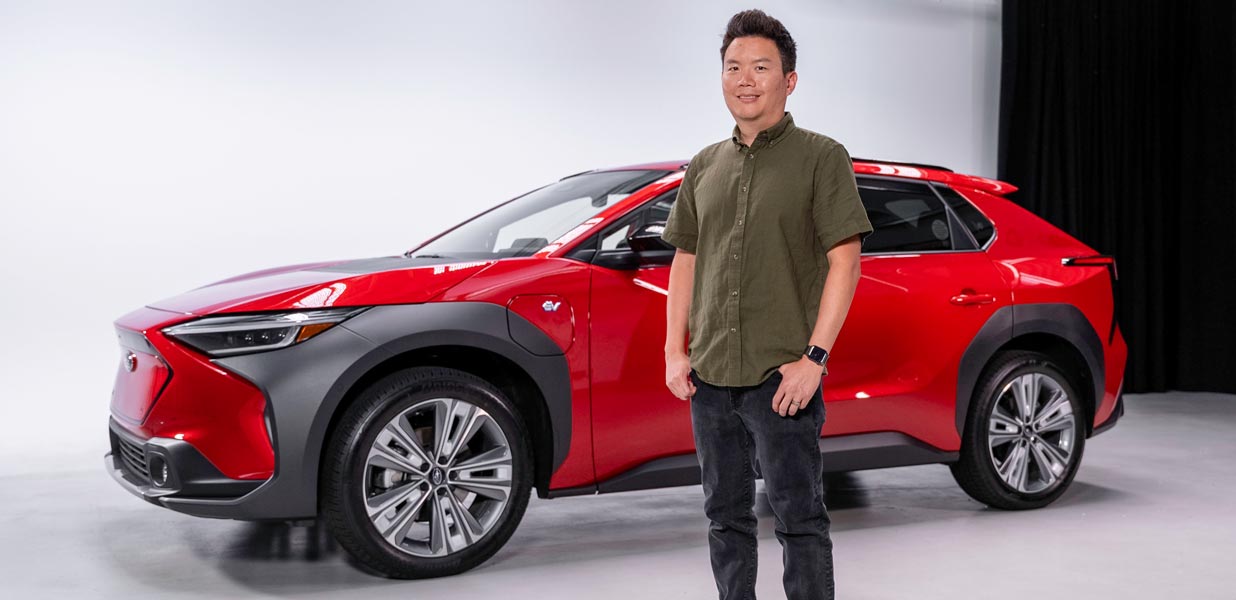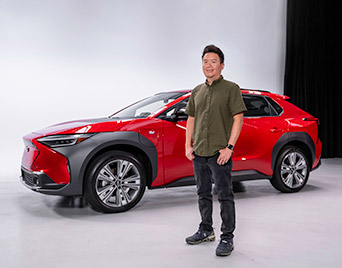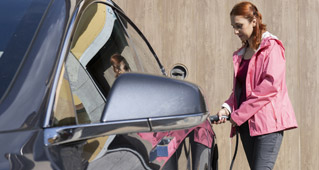Garrick Goh has spent almost 18 years with Subaru of America, and has worked on the development of alternative fuel and advanced technology vehicles there for the last 5 years. Most recently, he has played a leadership role in the rollout of Subaru’s first-ever all-electric vehicle: the Subaru Solterra.
The Solterra’s 2023 MSRP starts at $44,995 – not only under the average price of an electric vehicle ($53,400), but also under the average cost of a traditional gas vehicle ($48,800). And with an electric range of 225 miles, it can still reach those far-flung places that Subaru’s loyal drivers want to go – with loads of room for hiking boots inside, ground clearance outside, and a drivetrain that can outperform other offroad vehicles.
Chase Auto sat down with Garrick to learn more about what makes the Solterra a great EV, a great off-road vehicle, and a great Subaru.
On taking the Solterra to far-flung places
Research shows that Subaru owners are more open to EV ownership than most other vehicle brand owners. They are also more likely to drive off-road, traverse any terrain, and be active outdoors. How does the new Subaru Solterra manage the natural tension between the limited range of EVs with your drivers’ desire to travel to far-flung places – where there might be fewer opportunities to charge up?
Garrick: When we went into this project, we wanted to make sure that this car was a Subaru first. That means looking at what customers actually do with Subarus. They are taking them off-road more than other competitors. They are using them to go camping. They're using them to go hiking. They're using them to carry their bikes around.
Given all that, making sure the Solterra is a Subaru meant having features like a trailer hitch and a standard roof rack capability. And just having a regular roof rack wasn’t enough. We took an extra step to certify our roof rack for a static load capability of 700 pounds, so you could go rooftop camping with a friend and your dog if you wanted to.
And you'd be kind of surprised how far you can go on the 227-mile range. I recently took the Solterra to a trail clean-up event hosted by a Subaru enthusiast group focused on offroading. I was able to get there, play in the mud and the sand all day long, clean up the environment out there a little bit, and then come back and still have plenty of charge left.
But if you did want to go further than that, you do have the ability to fast charge it in roughly an hour. And if you want to do really far away Subaru things without worrying about how to recharge, we offer a free 10-day rental program where you can drop off your Solterra and borrow another Subaru model.
On making the Solterra a great offroading vehicle
What are some Solterra features that, like other Subaru cars, make it adept at navigating rocky, wind-y, off-road places?
Garrick: First-and-foremost, we have standard symmetrical all-wheel drive. That’s not just a marketing phrase; it actually does mean the car has to hold up to certain standards.
But we also put a ton of engineering time into making sure that our cars can do some surprisingly extreme things – and just because the Solterra is an EV doesn't mean it gets a pass from having those capabilities. For example, we test our cars’ ability to drive up a set of muddy stairs in a certain amount of time. Our customers may not ever be in that situation, but because the cars can do that sort of thing, it makes driving your kids to school in a snowstorm a piece of cake. It's really about driving confidence.
And if you do want to take it off-road or climb those muddy stairs, we have Dual Function X-MODE, allowing you to choose between different terrains, such as deep snow, mud, or dirt. We also have Grip Control, which is an off-road cruise control to take some of the stress out of driving off-road. We can really be aggressive with the traction control settings on the car, and you can climb over obstacles with a lot of ease.
And since Solterra is an EV, it actually can be better than gas cars in some situations because you have all that instant low-end torque. You can go through some surprisingly deep puddles with the Solterra – which has a wading depth of 19.7 inches – because you don't have an engine that you have to worry about sucking in a bunch of water.
On making the Solterra a great EV
Let’s talk about the EV-specific features of Solterra. How does it stand out from other EVs on the market? Does Subaru offer any EV-specific incentives to drivers?
Garrick: Something I hear from a lot of people who drive a Solterraopens in new window for the first time is, “Wow, I’m surprised, it actually feels like a Subaru.” And I take that as the highest praise we can get. A common observation from new Solterra drivers is about the lack of harsh noise vibration and the impressive handling, which our engineers spent a lot of time on. I feel secure that we have the right combination of comfort and handling in our EV.
Along the incentive lines, we offer a few things specifically for our Solterra drivers. First, there’s the free 10-day rental of another Subaru SUV if you really want to go to a far-flung place where there aren’t a lot of opportunities to charge. Second, we offer a $400 credit toward either public fast charging with EVGo or a home installation of a Level 2 EV chargeropens in same window from Qmerit. Our hope is that these incentives help make the transition to EVs a little easier for our drivers. Finally, new 2023 Subaru Solterra models leased through Subaru Motors Financeopens in same window*same page link to footnote star link are eligible for the federal government's $7,500 incentive. Same page link to footnote reference 1
On the design
Ok, we’ve covered lots of substance so far. What about the look of the Solterra? You’ve said that this car wasn’t designed for “prestige or status” and that your loyal Subaru customers don’t want a car that “looks like a science experiment.” So, how would you describe the aesthetic style of the Solterra? When a customer first sees the Solterra, what impression are you hoping they get?
Garrick: If you ask someone who is really into cars or engineering, they can see that the proportions of the Solterra are more EV than gas. But you’re right that ‘science project’ was not the look we were going for. From the beginning, we wanted this to be a car that you could use every day, an SUV that you don't mind getting beat up, getting dirty, throwing the dogs in – ready for anything, is what we call it. In other words, we wanted to make a genuine Subaru SUV. Electrified, yes. Advanced, yes. But not trendy or weird.
In an early styling clinic with focus group participants, we had two competitor EVs in the room with the Solterra. When we asked ‘which one do you think is the SUV,’ they all pointed at the Solterra. When we followed up to ask why, they said the other EVs were “too pretty” and “too delicate.” They’d be afraid to get those cars scratched or dirty. They wouldn’t put their dogs in those cars. But they’d totally use the Solterra for those kinds of activities – and that’s the vibe we were going for.
On timing and the EV marketplace
You’ve been with Subaru for almost 18 years, and helping develop alternative fuel vehicles for nearly 5 years. Looking back, what stands out to you as the key changes in the EV marketplace that made it the right time for Subaru to develop the Solterra?
Garrick: I would say it's a combination of two things. One is customer feedback. Subaru customers have always considered themselves to be global citizens – protectors of the Earth, if you will. They're always looking for ways to better the planet, and they're not concerned with prestige. Automotively speaking, EV is the clear path forward. The second factor was timing and technology. If you back up maybe 15 years ago, the technology just wasn't there for our customers, who would not accept a 150-mile city car or a super trendy six-figure car. Now we’re reaching that point where the customer desires, the range, and the price are all coming together.
Last call
Over the course of your career, are there any specific vehicles, vehicle features, or technological milestones that stand out to you as among your personal favorites or most memorable?
Garrick: Ever since the late 1970s when I first started chewing on toy cars, we've had small incremental improvements. But now, with EVs, there's this massive leap forward into a completely different kind of vehicle. So I’d have to say that electrification is the most momentous change for me. Not just because of what I do at work, but in general.
We are also used to gas cars. We've grown up driving gas cars. Our parents grew up driving gas cars. Our grandparents had gas cars. There are things about gas cars that we are used to. They vibrate, they make noise. You need to rev them up before you make any power. They're stinky when you first turn them on in the morning. They need maintenance. Eventually they leak oil. There's all sorts of things we’re just accustomed to.
And then once you take all that away, it's like you stepped into the future – you're driving this completely silent car that has so much instant response. And you don't ever need to get oil changes or worry about replacing catalytic converters. It's a whole new world, and it's something that's kept my enthusiasm for the automotive industry going. It's a lot of fun.











